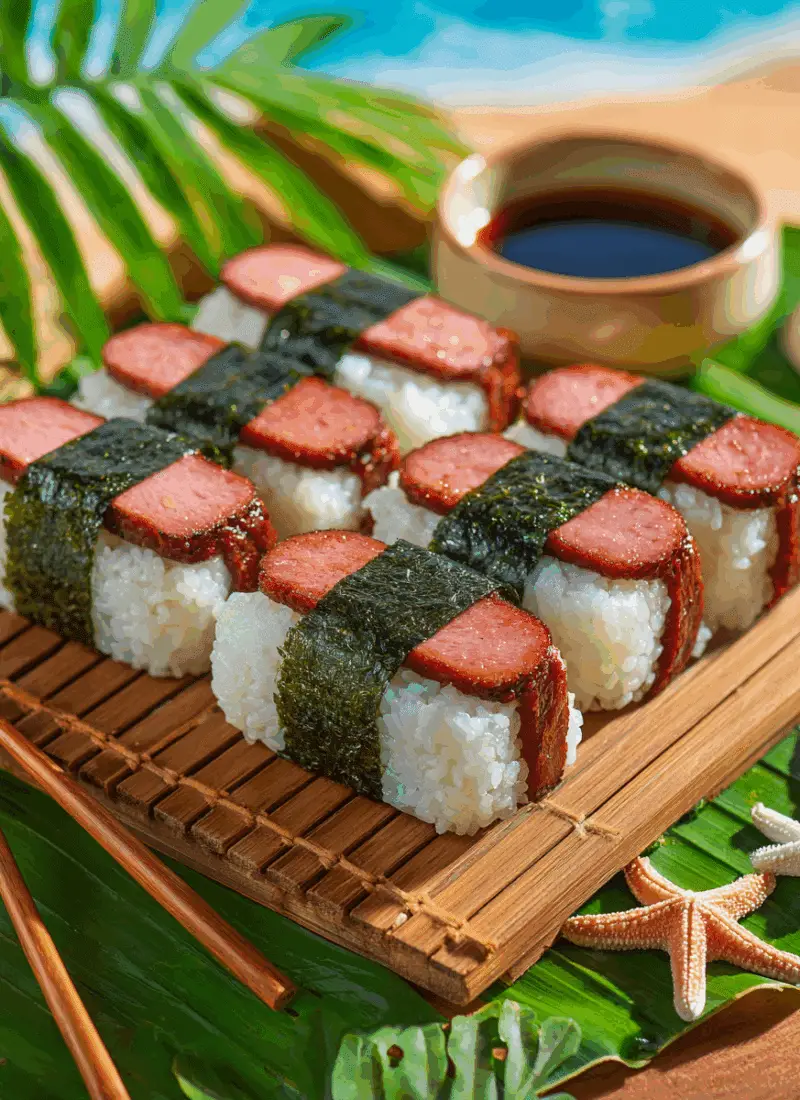Luncheon Meat Musubi is a popular Hawaiian snack and lunch item made with seasoned rice and fried slices of canned luncheon meat, commonly known by the brand name Spam. Inspired by Japanese onigiri, this handheld treat combines sweet, salty, and savory flavors in a simple seaweed-wrapped rice block that’s both satisfying and portable.
FULL RECIPE
Ingredients
- 2 cups cooked short-grain white rice (warm, not hot)
- 1 (12 oz) can luncheon meat (e.g., Spam)
- 2 tablespoons soy sauce
- 1 tablespoon oyster sauce (optional for extra umami)
- 2 tablespoons sugar
- 1 tablespoon mirin (optional)
- 1 tablespoon cooking oil
- 2 sheets nori (dried seaweed), cut into halves or thirds
- Plastic wrap or musubi mold (optional, for shaping)
Directions
- Cook the rice: Prepare short-grain white rice according to package instructions. Keep it warm and covered.
- Prepare the luncheon meat: Slice the canned luncheon meat into 8 even slices.
- Mix the sauce: In a small bowl, combine soy sauce, sugar, oyster sauce (if using), and mirin. Stir until sugar is dissolved.
- Fry the luncheon meat: Heat oil in a pan over medium heat. Fry each slice of meat until golden and crispy on both sides (about 2–3 minutes per side).
- Add the sauce: Pour the sauce mixture into the pan and simmer until it thickens and glazes the meat slices. Flip the slices to coat both sides. Remove from heat and let cool slightly.
- Shape the rice: Place a sheet of plastic wrap or a musubi mold on a flat surface. Add about ¼ cup of warm rice and press it down to form a compact rectangle the same size as the luncheon meat slice.
- Assemble the musubi: Place one glazed meat slice on top of the shaped rice. Wrap a strip of nori around the middle, sealing it with a dab of water or pressing it against the warm rice to stick.
- Repeat: Continue shaping and assembling until all slices are used.
- Serve or store: Serve immediately or wrap each musubi in plastic wrap to keep fresh for later.
Nutrition Facts
- Calories: 280
- Total Fat: 13g
- Saturated Fat: 4.5g
- Cholesterol: 40mg
- Sodium: 730mg
- Total Carbohydrates: 30g
- Dietary Fiber: 1g
- Sugars: 5g
- Protein: 10g
- Vitamin A: 2% DV
- Vitamin C: 0% DV
- Calcium: 1% DV
- Iron: 6% DV
Cultural Origins of Luncheon Meat Musubi
Luncheon Meat Musubi has its roots in Hawaiian cuisine, where diverse cultures blend into a vibrant culinary landscape. This snack reflects the influence of Japanese immigrants in Hawaii, who brought their love for rice balls (onigiri) and nori. During World War II, canned luncheon meat became a staple in the Pacific due to its long shelf life and convenience. Hawaiians embraced it, and eventually, the fusion of rice, Spam, and seaweed evolved into the beloved musubi we know today. Today, it’s not just a food item—it’s a cultural symbol and a nostalgic favorite across generations.
Flavor Profile and Taste Appeal
Luncheon Meat Musubi delivers a unique taste experience that’s both comforting and crave-worthy. The salty-sweet glaze on the pan-fried luncheon meat complements the neutral, slightly sticky white rice. The nori adds a layer of umami and a subtle oceanic note, rounding out the overall flavor. The balance between crispy meat edges, soft rice, and chewy seaweed makes it satisfying in both taste and texture. This harmony of flavors appeals to a broad range of palates, making it a go-to snack or light meal for all ages.
Nutritional Value and Considerations
While musubi is undeniably delicious, it should be consumed in moderation due to its sodium and fat content, especially from processed luncheon meat. However, it does offer a solid source of protein and carbohydrates, providing quick energy and satiety. Opting for low-sodium or reduced-fat versions of luncheon meat can make the recipe more heart-friendly. Adding vegetables like cucumber slices or avocado can also increase the nutritional profile without compromising taste. For active individuals or those needing an energy boost, musubi can be a convenient, portion-controlled option.
Popular Variations
There are countless ways to customize luncheon meat musubi to suit different tastes or dietary needs. Some popular variants include adding scrambled eggs, kimchi, or teriyaki sauce. You can also make deluxe versions by layering in avocado, furikake (Japanese rice seasoning), or cheese. Vegetarian versions substitute grilled tofu or tempeh for the meat. Some even experiment with flavored rice, like sushi rice seasoned with rice vinegar and sugar, for a tangier bite. These variations keep the musubi exciting and adaptable to different preferences and cultural fusions.
Serving Suggestions
Luncheon Meat Musubi is versatile in presentation and occasion. It can be served warm or at room temperature, making it ideal for bento boxes, potlucks, or picnics. For a fuller meal, serve it alongside pickled vegetables, miso soup, or a fresh green salad. Musubi can also be sliced in half diagonally for more elegant serving options during gatherings. Wrapping each one in wax paper or foil makes it portable and perfect for school lunches or office snacks. No matter the setting, musubi fits seamlessly into casual or planned dining scenarios.
Pairing Ideas
Pairing musubi with the right side dish or drink can elevate the entire eating experience. Try it with iced green tea, a miso soup starter, or a chilled cucumber salad for a refreshing balance. For a Hawaiian-style lunch, serve it with macaroni salad and pineapple slices. Bold eaters might enjoy pairing it with spicy mayo or Sriracha on the side. Light beers or sake also complement musubi well during casual dinners or small get-togethers. These pairings enhance the umami-rich profile while keeping the meal balanced and enjoyable.
Storage and Shelf Life
One of the advantages of musubi is its ability to be made ahead and stored for later use. Once assembled, wrap each musubi tightly in plastic wrap to keep the rice from drying out and to preserve the moisture of the meat. They can be kept at room temperature for a few hours, making them ideal for packed lunches. For longer storage, refrigerate and reheat gently in the microwave while still wrapped to retain moisture. However, for best taste and texture, it’s recommended to consume within 24 hours of preparation.
Make-Ahead Tips
Preparing musubi in advance is a great strategy for meal prep or busy weeks. Cook the rice and fry the meat slices ahead of time, storing them separately in airtight containers. You can also pre-cut the nori sheets and prepare the sauce mixture in advance. When ready to assemble, simply warm the components slightly and shape them as needed. Using a musubi mold can speed up the process and ensure uniform sizes. These simple prep tips allow you to enjoy fresh musubi with minimal daily effort.
Kid-Friendly Appeal
Luncheon Meat Musubi is a big hit among kids due to its finger-food format and mild, savory-sweet flavor. The compact size and familiar ingredients make it less intimidating than other exotic or spicy dishes. You can make smaller “mini musubi” versions for little hands or add cute seaweed cutouts for visual appeal. Involving children in the assembly process also turns it into a fun kitchen activity. Because it’s easy to eat and not messy, musubi makes a reliable and kid-approved addition to lunchboxes or school picnics.
Budget-Friendly and Convenient
This recipe is incredibly cost-effective, using basic pantry staples and stretching a single can of luncheon meat into multiple servings. Rice is an affordable and filling base, while nori sheets and soy sauce can be bought in bulk and stored long-term. With minimal tools and quick cooking time, musubi is perfect for college students, busy families, or anyone seeking a fast and satisfying meal. Its simplicity, affordability, and flexibility make it a smart choice for meal planning without sacrificing flavor or quality.
Conclusion
Luncheon Meat Musubi is more than just a tasty snack—it’s a cultural icon that reflects culinary ingenuity and the blending of traditions. From its wartime origins to its present-day popularity, it continues to delight food lovers with its balance of flavors, ease of preparation, and endless variations. Whether you’re looking for a quick lunch, a party treat, or a nostalgic comfort food, musubi offers something for everyone.








